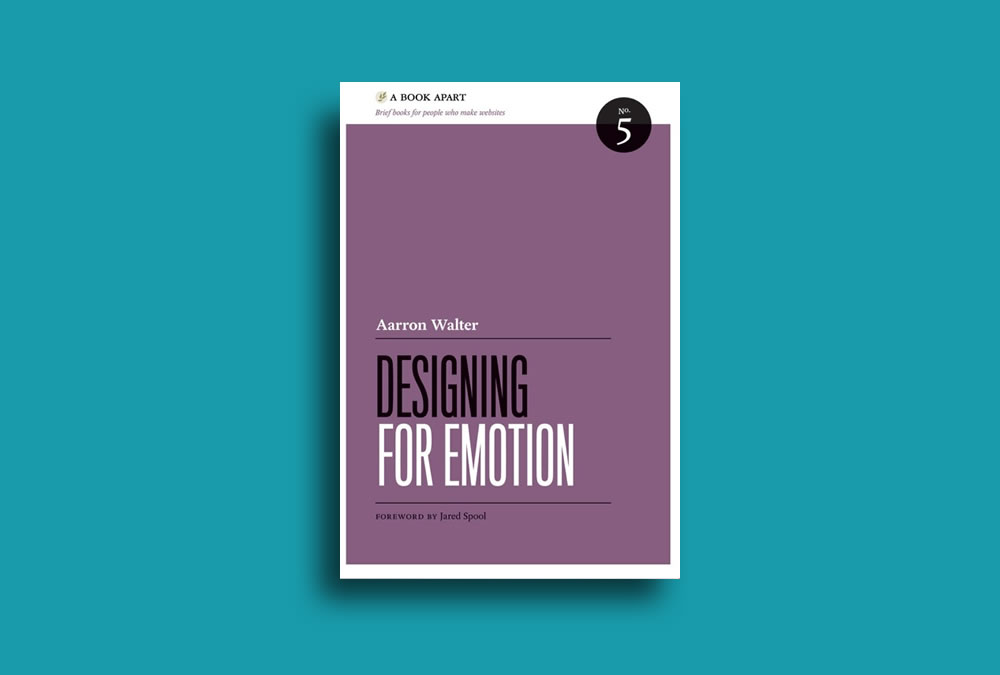Designing for Emotion – 1st Edition
By Aarron Walter
As designers, we want our work to rise above the sea of sameness. To be remarkable. Memorable. To make a lasting impression. This only happens when we achieve delight.
In this quintessential book, written in 2011 and bursting with wisdom, Aarron Walter lays the groundwork to reach the goal of delight. Please note, the 2020 Edition is available!
EMOTIONAL DESIGN
Aarron explains how it’s essential to preserve the human touch and show ourselves in our work. We do this with a combination of psychology and craftsmanship: to create a user experience that makes visitors feel the person at the other end.
Mirroring Maslov’s hierarchical needs, the baseline interface must be functional, reliable, and usable. The top of the pyramid is pleasure, joy, fun! If designers create an extraordinary experience, it will be memorable.
I love his analogy of recalling the best meal you’ve ever had. What made it so special? It’s the combination of taste, unexpected flavors, presentation, attentive wait staff, ambiance, that all culminate in a grand experience to elicit an intense emotional response.
Even if it’s been years, we can each recall our best meal. Because emotionally charged events create memories that persist much longer.
Our websites should strive for “best meal” excellence.
Positive emotional stimuli build engagement. Reward people with positive emotion by letting your brand’s personality show, and turn casual users into fanatics ready to tell others about their experience.
DESIGNING FOR HUMANS
Hick’s Law: The time it takes to make a decision increases with the number of alternatives. Attention is a finite commodity.
When this was written in 2011, I would agree. Now, it’s critical. Our daily bombardment of media has us inundated, over-saturated, buried alive.
Brilliant web design cuts through the noise.
Emotional design isn’t just about copy, photos, and design style. It’s a different way to think about how you communicate.
Consider the power of aesthetics — color, typography, scale, white space, layout. Design influences our emotional engagement and usability. Beautiful design creates a positive emotional response in the brain, which improves our cognitive abilities.
Design is too often wrongly taken for the indulgent frosting on a functional interface. Again, Aarron uses a brilliant analogy — would you show up to a job interview in your PJs? Nope. Perceptions are critical.
BRAND PERSONALITY
Personality greatly influences our decision-making process. It’s the mysterious force that attracts us to certain people and repels us from others. Recall a recent interaction where you made a real connection — engaging, interesting, fun, exhilarating. Your personalities intersected at shared jokes, tone of voice, the cadence of the conversation.
That’s the feeling to strive for. Bond with your audience by designing a personality the interface will embody.
PERSONAS
It’s equally important to think of your target audience’s personality. As web designers, we research, plan and create with our audiences’ attitudes and motivations in mind.
Personas: a dossier on an archetypal user who represents a larger group.
Creating a personal for your site’s target audience helps stay focused on their needs. You basically create a fictitious person that represents your audience. Specifics help. Include a photo, traits, personality map, voice, copy examples, visual lexicons (color, type, style), engagement methods.
EMOTIONAL ENGAGEMENT
Surprise and Delight: Amplify emotion with easter eggs, take the mundane and give it a clever twist, add a personal element like handwritten notes. Eliminate the ho-hum and sprinkle in the wow!
Anticipation and The Velvet Rope: Entice visitors by announcing something exclusive awaits them. Prime a visitor by exposing them to a stimulus, like a countdown to an event or special item that is only available for a short time.
OVERCOMING OBSTACLES
Combating Inundation: People aren’t lazy, but they are inundated and crave the path of least resistance. When people are reluctant to act, incentives can help.
Apathy: What if the site is met with a sea of indifference? First, check your content — because great content is always at the core of a successful site. Is it poorly presented? Too wordy? Missing the mark? Simple user research and usability tests can help inform your decisions.
***
Ruby Slipper highly recommends this book for web designers, marketing professionals, and nonprofits. Anyone who wants to make a memorable connection with their audience!
To purchase this book and view other brief books for people who design, write, and code, visit A List Apart.


 Every day, we are immersed in the fast-paced world of marketing and web design. Here, we share our insights with you!
Every day, we are immersed in the fast-paced world of marketing and web design. Here, we share our insights with you!